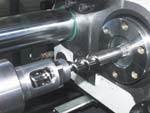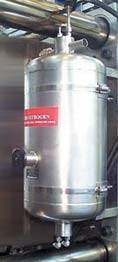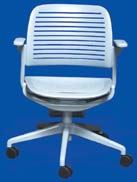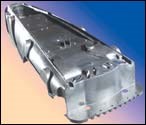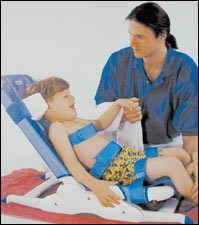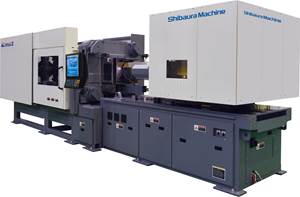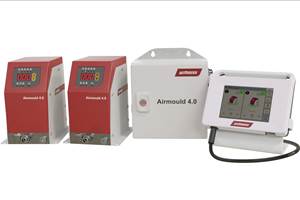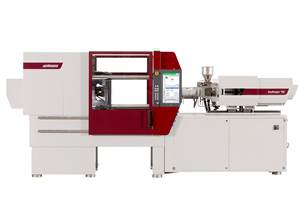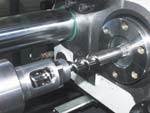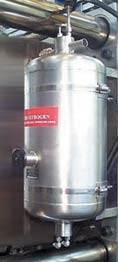Injection Molding Technologies Advance At Structural Plastics Show
A simpler approach to in-mold film decorating was one new injection molding capability presented at the SPI Structural Plastics show and conference.
A simpler approach to in-mold film decorating was one new injection molding capability presented at the SPI Structural Plastics show and conference. The application of gas-assist as a cooling agent and the first commercial use of a new coinjection process were two other developments revealed at the April meeting in Dearborn, Mich.
IMD without preforming
In-mold decorating (IMD) with printed or painted film inserts can be simplified with a new technique that eliminates preforming the film. Berdan Technology Consulting (BTC) in Canada, which specializes in gas-assist and IMD techniques, developed this approach for shallow moldings. It uses the heat and pressure of the injected melt to shape a flat film insert to the contours of the mold. Gas assist or foaming can be used together with IMD to make thicker parts and/or prevent sinks.
The flat-film approach does away with the process steps of preforming and eliminates the need to draw a vacuum on the mold face to hold a preformed insert in place. The complexities of robotic handling of inserts can also be avoided, since flat film can be indexed directly into the injection mold from a roll (though precut flat-film inserts are also usable).
The BTC process involves first positioning the film on mold locator pins—manually, robotically, or by automatic indexing. The pins are part of a system that holds the film between the core and cavity halves of the tool. Once the film is positioned, the mold closes and polymer is injected behind the film. The film is forced against the inner mold surface, forming the exterior of the part. “Under heat and pressure, the flat film has the ability to stretch and conform to a wide array of simple shapes,” says Karl Berdan, president. BTC can preheat selected areas of the film to increase its stretchability.
After molding, excess film is typically trimmed (using a laser is one approach), folded, and wrapped around the parting lines, then joined to the substrate with ultrasonic or laser welding. BTC has designed special fixtures for these secondary operations.
According to BTC’s studies of the process, this system can be used with parts up to 10-12 mm deep. Tapered parts and reverse drafts can be molded, though deep recesses close to edges, extreme reverse angles, and sharp corners should be avoided, Berdan says. Important process parameters include adjustment of material fill rates for proper film stretching and careful attention to mold temperature. Antistatic devices help control dust attraction that can mar cosmetic surfaces. Critical tooling concerns are gate type and location, ejection from the core (non-appearance) side, and proper venting to remove air between the film and substrate.
Gas flows for cooling
The role of the gas in gas-assist molding is expanding to include cooling enhancement in addition to the mechanical coring function. A variation on the gas-assist process licensed by Cinpres Gas Injection Inc. cores out the part with cooled gas and then provides a continuous flow of cool gas through the part during cooling. “Cooling cycle times can be reduced by at least 20%, and in some cases up to 40%, compared with conventional gas molding,” says Cinpres v.p. and general manager Mark Paddock of the firm’s new Gas Cool process. In addition, he notes that the leading edge of the cooled gas during injection exhibits a plug-flow effect that results in a smoother, more uniform inner wall.
Cinpres is the second firm this year to roll out a “cold” gas-assist technique. Another one, called KoolGas, comes from Warwick Manufacturing Technology in Coventry, England. It uses liquid nitrogen to cool the injected gas and is said to cut cooling cycle times by 10-60% (see PT, June ’02, p. 37).
The Cinpres Gas Cool process compresses nitrogen gas to 5250 psi, then uses a high-pressure dryer to remove moisture and a high-pressure chiller to drop its temperature as low as –22 F. The process requires modification of the in-mold gas injectors to handle the chilled gas and to avoid material blockage. The cooled gas is injected at pressures of 1500 to 3000 psi and the flow continues at a rate of 150 to 200 liters/min to continue pressurizing the part during cooling. As a result, Gas Cool requires triple the volume of gas required for standard gas-assist. For this reason, Paddock recommends use of an on-site nitrogen generator instead of bottled gas.
Controlled flow of gas through the part during cooling can be achieved using a variation of CGI’s new Plastic Expulsion Process. The PEP process pressurizes the mold and then opens a valve to allow expulsion of melt into an overflow cavity (PT, June ’02, p. 37). For Gas Cool, a vent pin is added in the overflow cavity. The pin extends into the overflow cavity during injection. Then the pin retracts, leaving a hole for gas to escape. A pressure-relieving system outside the overflow cavity controls the outflow of gas to maintain pressure in the mold.
Gas Cool is used in proprietary applications at three installations in Brazil and in Europe, says Paddock. CGI offers the process for licensing at approximately $15,000, not including equipment.
Single-barrel coinjection
A bath chair for disabled children represents the first commercial application of a new coinjection technology that uses conventional injection machines with a single barrel. Developed by Twinshot Technologies, the new technology plasticates both components within a single barrel using a two-stage screw and a separate hopper to feed each stage. “It’s a design similar to a vented extruder approach,” says Joel Thomson, plastics engineer and inventor of the technology. “The ratio of materials is controlled externally by starve feeding one or both of the screw stages,” he says. Melt in the first stage bypasses the second stage by means of a channel through the center of the screw.
The new version, called Twinshot Version II, replaces an earlier “screw-within-a-screw” design. It is retrofittable to all conventional machines and can be used without modifying the mold (PT, March ’02, p 11).
The technology is being used to produce the Blue Wave Bath Chair for Rifton Equipment, Rifton, N.Y., a sister company of Twinshot Technologies. The ABS chair supports are coinjected with a foamed core of 100% post-consumer ABS recovered from electronic housings. The PP seat members are cored out with a liquid gas assist, which leaves no vent holes.
Coinjection with a foam core allows the ABS parts to be run on a press with one-third the clamp tonnage of the previous solid versions. Less warping, sink marks, and flash also result.
Related Content
Completely Connected Molding
NPE2024: Medical, inmold labeling, core-back molding and Industry 4.0 technologies on display at Shibaura’s booth.
Read MoreInternal Gas Pressure Molding Offers Sustainability Benefits
Wittmann Battenfeld says its upgraded Airmould 4.0 technology, which features a more compact footprint, saves material and cycle time — thereby also cutting energy use.
Read MoreFakuma 2023: Wittmann Battenfeld Expands All-Electric Line, Direct-Current Capabilities
Wittmann Battenfeld will introduce the new EcoPower B8X injection molding machine line and show direct current as an energy source for a concept machine that will power its own robot.
Read MoreRead Next
Coinjection's New Look: Two Screws, One Barrel By Mikell Knights
Coinjection molding has always been viewed as a cost-saving technique that can put a lower cost material such as off-spec, recycled, unpigmented, or foamed resin into the core of a two-material sandwich. Coinjection also aids a molder looking to make value-added products such as soft-touch parts or ones with a cosmetic surface over a glass-reinforced core.
Read MoreNew Methods Expand Roles of Gas-Assist Molding
Two variations on gas-assist injection molding were presented in papers at the Molding 2002 Conference held in New Orleans in March.
Read MoreMaking the Circular Economy a Reality
Driven by brand owner demands and new worldwide legislation, the entire supply chain is working toward the shift to circularity, with some evidence the circular economy has already begun.
Read More
